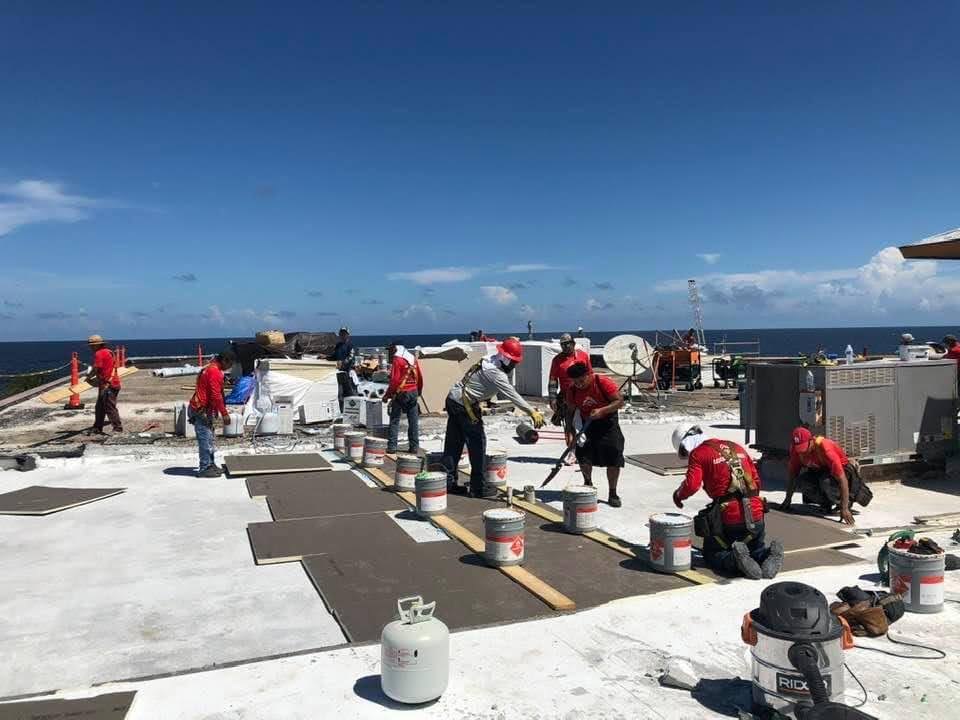
Are you looking for a commercial roofing contractor to do “Commercial Roof Maintenance in Savannah, Georgia?”
Recurring commercial roof maintenance is a specialized roofing service that requires extensive roofing knowledge about all aspects of commercial roofing materials. To be able to properly inspect and perform the correct maintenance service we first need to understand the many different types of commercial roof systems.
But we can assure you that if you are in the Greater Savannah Area, you have come to the right place to learn about the commercial roof maintenance available for you.
Here at RoofCrafters of Savannah, we've been helping educate our commercial property management partners and our commercial building owners in the Greater Savannah area for over 29 years. By doing so, they've been able to make well informed decisions about maintaining their existing commercial roof systems.
We' re certified by the top flat manufacturers and the steep slope commercial roofing manufacturers. These top roofing manufacturers help our commercial roofing team stay up to date with the latest maintenance requirements for all the different commercial roofing systems that are out there.
So what does that mean for you?
Well, this enables us to provide you with expert commercial roofing maintenance plans to help prolong the life of your existing commercial roofing system.
In this article we're going to cover:
- 3 different types of commercial roof structures
- The 5 most common types of commercial roof systems
- Maintenance recommendations for each of the 5 roof types
- The average cost for commercial roof maintenance
And we can promise you by the end of this article you will be an expert in all things commercial roof maintenance related. And hopefully, by the end you'll be able to make a well-informed decision and learn how to proceed with getting your commercial roof maintenance scheduled.
Let’s get started.
3 Types of Commercial Roof Construction
There are 3 main types of roof designs used for constructing a commercial building.
- Flat roof commercial construction
- Low slope commercial construction
- Steep slope commercial construction
Flat roof commercial construction is very common, it allows an engineer or an architect many options for mounting roof top mechanical equipment. Also, reduced structural requirements that often come with steep-sloped commercial construction.
With the newer single-ply roof systems today, this type of construction requires your local commercial roofing contractor to slope your roof using tapered insulation. This eliminates any ponding water on your commercial roof. The tapered insulation also provides your building a higher R-value which will help make your commercial building more energy-efficient. This tapered insulation will impact the overall cost of the roofing construction.
Low slope commercial construction is where the engineer or architect has designed the commercial building so that the roofing structure has a positive slope built into the construction of the roof framing. This slope creates positive drainage and allows the water to properly run off the rooftop.
The downside to low slope roofs is that it is not always a good fit for all the different types of commercial roofing materials that building contractors install on them.
For example, a low slope roof that someone has installed a metal roof and has rooftop mechanical equipment such as HVAC units or even skylights is typically NOT the best option. Choosing an inferior roofing material will result in early roof leaks and create maintenance issues that another commercial roof system would not have on this type of commercial low slope roof construction.
Steep slope commercial construction roof on a commercial property is identical to residential steep slope construction. The most common construction types on steep slope commercial roofs are a gable roof or a hip roof. Gable and hip roofs on commercial buildings are constructed with metal or wood trusses. Steep slope roofs can also be constructed with custom wood framing too.
The most popular roofing materials installed on commercial steep slope roofs are standing seam metal roofs, screw-down metal roof systems, metal shingles, Spanish tile, and any of the 4 different asphalt shingles.
Now that you know about the different types of commercial roof construction let’s talk about the top 5 types of commercial roofing products.
Top 5 Commercial Roofs Installed in Savannah, Georgia
- Single-ply roofing (TPO, PVC & EPDM roofing)
- Modified Bitumen (rubber roofing)
- Built-up roof (hot tar roofing)
- Metal Roofing (standing seam & screw down)
- Asphalt shingles (upgraded architectural & designer shingles)
Single-ply roofing (TPO, PVC & EPDM roofing)
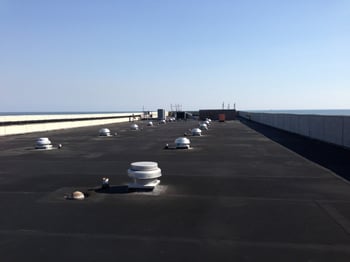 Single-ply roofing has been one of the fastest growing and one of the most popular commercial roofing materials used on low sloped commercial roofs. Single-ply roofing is available in different thicknesses. This is to help provide you options to help meet your budget and lifespan requirements.
Single-ply roofing has been one of the fastest growing and one of the most popular commercial roofing materials used on low sloped commercial roofs. Single-ply roofing is available in different thicknesses. This is to help provide you options to help meet your budget and lifespan requirements.
The higher the number, the thicker the product. The thicker the product the longer the manufacturer warranties their single-ply roof material.
Single-ply TPO and PVC roof is made up of 3 layers. A base layer, the scrim layer(reinforced woven fiber layer), and thickness over the scrim layer, which is the top layer. This top layer protects the scrim layer from the sun’s harmful uv rays.
An EPDM roof comes in a 45 or 60-mil thick membrane. The difference is the laps and flashings on this commercial roofing material are glued or seam taped together instead of hot air welded like the TPO or PVC single-ply materials.
The advantage of single-ply roofing is they come in white which makes them heat-reflective and energy efficient. They’re also lightweight, fire-resistant, they provide a high wind rating, and are resistant to chemicals and pollutants which can be important in commercial and industrial roof applications.
Single-ply roofs are also easily repairable and easy to keep maintained.
The disadvantages of single-ply roofs are they are not designed to add curb appeal. Single-ply roofing is commercial grade and not a very pleasing roof to look at. High foot traffic could pose a threat if the contractors are not mindful when performing work on the roof, dropping hand tools or screws and then walking on them could puncture single-ply commercial roof systems.
Modified bitumen roofing (rubber roof)
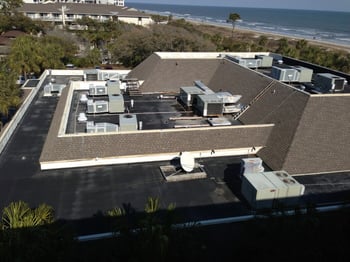 We'd like to say a Modified bitumen roof is the second generation of commercial flat roofing. Built-up or hot tar is the original flat or low sloped roofing of the flat roofing materials and we will discuss that in the next section. Modified bitumen became popular because unlike the hot tar roof that requires setting up a hot tar kettle Mod-bit does not require pumping hot asphalt.
We'd like to say a Modified bitumen roof is the second generation of commercial flat roofing. Built-up or hot tar is the original flat or low sloped roofing of the flat roofing materials and we will discuss that in the next section. Modified bitumen became popular because unlike the hot tar roof that requires setting up a hot tar kettle Mod-bit does not require pumping hot asphalt.
That job alone, heating asphalt onsite, next to your building, at over 500 degrees is a full-time and extremely dangerous job.
The roofing industry has been moving away from hot tar roofing. Modified bitumen roofs can be installed with hot tar but the most popular installation methods are without the hot tar.
Here are 4 main installation methods.
- Hot tar applied
- Cold tar applied
- Torch applied
- Self-adhered
The last 3 installation methods, cold tar applied, torch applied, and self-adhered are what have made modified bitumen roofs more efficient and popular for commercial roofing applications.
The advantages of Mod-bit roofs are they have multiple layers and having multiple layers can make them more durable. This increased durability can make the mod-bit a better choice for commercial roofs that may have high foot traffic.
The disadvantages of Mod-bit with these multiple layers are that it costs more to buy the materials and the labor to install multiple layers is more expensive. Also performing repairs and maintenance on mod-bit roof systems can be more difficult, increasing the cost.
Built-up roofing (hot tar roof)
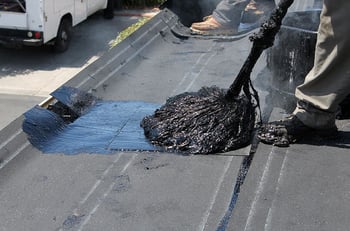 A built-up roof can be your best friend or your worst nightmare. There are so many variations or layers of roofing materials that make up a built-up roof system.
A built-up roof can be your best friend or your worst nightmare. There are so many variations or layers of roofing materials that make up a built-up roof system.
Layering the materials is how it got called a built-up roof. The roof is built-up by layering plies of fiberglass rolls of roofing and hot tar between each layer. And this is only the short explanation of how it gets installed.
The basics of a hot tar roof is its asphalt heated up to over 500 degrees and then mopped directly on the roof deck or to the insulation. Yep, just like you would mop a kitchen floor. And in between mopping we roll out layers of roofing materials while the asphalt is still hot.
Many built-up roofs are done with 4, 5, or 6 layers of roofing with hot tar being applied between every layer.
The top layer is the most important layer when it comes to maintenance. It’s what determines if it can be repaired and maintained successfully. Oftentimes the top layer is a flood coat of hot asphalt (tar) with rocks put in the tar while it is still over 500 degrees. A hot tar roof with a rock or gravel finish makes for a challenging repair even for a very experienced commercial roofer.
However, it can be done if there is useful life left in the hot tar flat roof system.
Now, if it has a granule surface cap sheet as a finish layer or an asphalt flood coat, it is much more manageable to maintain and repair. Either way, the existing roofing materials that will need to be maintained require some useful life left to make any repairs that will last you any length of time.
Metal roofing (standing seam & screw-down roof)
Metal roofing is another popular roofing option for any commercial building.
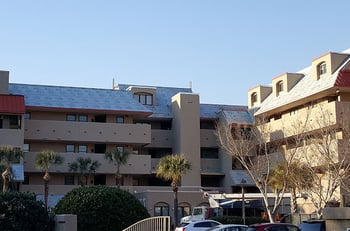
There are 3 main types of metal roof systems:
- Standing seam metal roofing
- Screw-down metal roofing
- Metal shingles
Standing seam is a concealed fastener metal roof system and screw-down metal is a metal roof with an exposed fastener mechanically fastened through the surface of the metal roofing.
Both metal roof systems have their own advantages and disadvantages.
The advantages of the standing seam is their longevity, properly installed they will easily last for 50 to 75-years, standing seam roof applications also provide you a very high wind rating, they don't blow off in severe wind storms. Standing seam metal looks great and can add value to any commercial property.
The disadvantages are the cost, one, because of the attachment method and second it requires a much higher skill level to install all the flashings for this system and so it takes longer to install which also drives the cost up more.
The advantages of the screw-down roof are they are cheap and still provide your building curb appeal, most people love metal. The disadvantage is they require maintenance within the 5-year mark. With all the expansion and contraction(thermal movement) that happens with all metal roofs, the exposed screws can come loose. And they do!
Metal shingles are very popular as they can be made to look like real wood shakes, real slate, and real Spanish tile roofing. All of the natural products require more maintenance than the metal shingles require making these a very popular choice for owners looking for longevity and added curb appeal.
There are 3 common types of metal roof materials that are installed on businesses in Savannah, GA:
- Aluminum
- Steel
- Galvalume
There are several other commercial metal roofing material options however these 3 metal roofs are the most economical and cost-effective. These are the most popular of the metal options. The 3 of these metal roofing materials combined offer you a wide range of curb appeal, longevity, and varying price ranges as well.
All of these metal materials are available in standing seam metal or screw-down metal profiles as well as shingle, slate, wood, and tile metal style profiles (the metal shingles are made to look like these real products).
Aluminum metal roofing
Aluminum is one of our most natural energy efficient metal roof materials available. Aluminum metal comes in different thicknesses and typically for roofing we use a 032, 040, or 050 thickness. The higher the number the thicker the aluminum roofing will be. The 032 and 040 thicknesses are most popular on commercial roof installations.
Aluminum comes in a mill finish or a painted finish. Mill finish will provide you with a raw metal look and it will oxidize into a naturally raw metal finish. Aluminum comes in a wide variety of painted finished colors. Most of the paint finishes come with a 40-year paint warranty with some manufacturers even providing a 45-year paint finish warranty.
Steel metal roofing
Steel roofing is the most popular metal roofing material used for roofing commercial buildings. Steel metal is galvanized steel that is hot dipped or coated in a zinc coating. Steel is less costly and can be as effective and efficient as any of the other metal materials that are available.
The steel material is very popular for roofing and comes in 24 gauge, 26 gauge, and 29 gauge. Don't get fooled, unlike aluminum, the lower the number the thicker the steel roofing will be.
4 of the most common steel roofing profile that are installed on commercial roofs in Savannah, Georgia:
- Standing seam metal panels (12”-18” wide panels, concealed fasteners)
- Interlocking steel shingles (slate or shake look, concealed fasteners)
- 5-V crimp metal roofing (2 foot wide panels, exposed fasteners)
- R-panels or multi-rib panels (3 foot wide panels, exposed fasteners)
Because steel is not a non-corrosive metal, these metal roofing materials require a paint finish. Paint finish warranties range from 20-years to 45- years depending on the thicknesses, type of panel, and the manufacturer of the metal.
Steel metal roofing is very cost-effective and offers a wider range of prices depending on which profile you choose, the thickness of the metal, and the paint warranty available.
Galvalume metal roofing
Galvalume metal is also a metal that has a steel core and is coated with aluminum to prevent corrosion.
Galvalume is much like steel roofing and comes in the same thicknesses, 24 gauge, 26 gauge, or 29 gauge. It is also available in all 4 of the different panel profiles.
The main difference with galvalume is that it comes as a mill finish metal product, so it is not available in a painted finish. This makes it slightly less expensive and easier to work with as the painted materials can get scratched during installation if not handled carefully. It is also a great option to use around the ocean or if you live anywhere near the saltwater.
Asphalt shingles
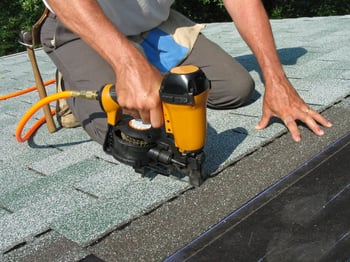 Even though shingles are mainly used on residential homes, I will guess that they are on your home and tell you, they are definitely on mine. Well, it is also very common for asphalt shingles to be installed on commercial buildings in Savannah too.
Even though shingles are mainly used on residential homes, I will guess that they are on your home and tell you, they are definitely on mine. Well, it is also very common for asphalt shingles to be installed on commercial buildings in Savannah too.
The shingles installed on commercial buildings in Savannah, Ga are typically not basic builder grade shingles that are used on new construction homes. The reason for this is that builder-grade shingles provide the least wind protection and require replacing every 10 to 12 years. Not ideal for an investment property.
Builder grade shingles also provide the least curb appeal.
Upgraded shingles, designer or luxury shingles are much more popular on commercial buildings. Upgraded shingles will provide you greater wind protection, enhanced curb appeal, and upgraded shingles can last 25 to 35-years.
The disadvantage of shingles is they don't last as long as the metal roofing and when it is time to replace the roof, it can be messy for a building with heavy traffic that comes with commercial properties.
What is the right type of commercial roof maintenance in Savannah, GA?
As you have learned, with the different types of construction and materials that are used, the maintenance for each of these different types will vary depending on 3 main factors:
- Type of roof construction
- Type of roof material
- Condition of existing roofing materials
If you have a steep slope roof in Savannah, performing maintenance one time a year is generally recommended. If the building has gutters or any other special condition that might increase to 2 times per year.
With a flat or low slope roof depending on the roofing materials we generally recommend having maintenance performed 2 to 3 per year. If the roof has multiple drains, through-wall scuppers, or multiple rooftop mechanical units we may recommend 3 to 4 times per year.
Other things to consider are the age of the existing roofing materials, the amount of tree coverage, and foot traffic on the roof.
The older a commercial roof gets the more it will expand and contract due to climate changes. This thermal movement often causes things to come loose as a roof ages and get older. Older roofs require a little more TLC to get the most out of them.
Tree coverage and high foot traffic can impact the performance of your roof if it is not accounted for. We also see building owners neglect their commercial flat roofing because they can’t see the roof.
Drains and through-wall scuppers get clogged causing all kinds of roofing issues. Unfortunately, workers that service rooftop mechanical equipment drop tools or screws and then step on them, this is why high foot traffic has to be accounted for when creating a solid maintenance plan for your commercial building.
Now that you are well educated on commercial roofing and commercial maintenance, here are the next steps to getting a commercial maintenance plan for your commercial building.
But first, you may be asking yourself, “How much does commercial maintenance cost in Savannah, GA?”
How much does commercial roof maintenance cost in Savannah?
It really depends on the type of commercial building in Savannah, Georgia that you want to have roof maintenance performed on.
Here are the questions we need answers for to provide you with the exact cost:
- Is it a steep slope roof with shingles or a metal roof or is it a low slope or flat roof with a single-ply or modified bitumen roof system?
- What is the total square feet of the roof area?
- How many drains, penetrations, or mechanical units does it have on the roof?
- What kind of condition is the existing commercial roof system in?
However, on average commercial roof maintenance costs between .15 cents per square foot to .30 cents per square foot. So, to perform roof maintenance on a 20,000-square-foot building, you would be looking at somewhere between $3,000 and $6,000 dollars depending on the specific factors of the building and existing condition of the commercial roof system.
Our team here at RoofCrafters has been providing commercial roof maintenance in Savannah, Georgia for nearly 3 decades. If you would like to have one of our professional commercial roof estimators come out and perform a thorough roof inspection and provide you with pictures and a solid solution for your commercial roof maintenance, schedule your inspection here and we look forward to serving you.
At RoofCrafters, our mission is to provide job opportunities for others to thrive and grow while making a meaningful impact within our communities.

